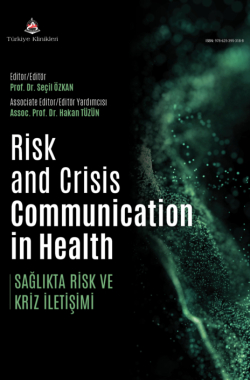Crisis Communication in Healthcare Organizations
Rabia AYGÜRa , Hakan TÜZÜNa
aGazi University Faculty of Medicine, Department of Public Health, Ankara, Türkiye
Aygür R, Tüzün H. Crisis communication in healthcare organizations. In: Özkan S, ed. Risk and Crisis Communication in Health. 1st ed. Ankara: Türkiye Klinikleri; 2024. p.73-8.
ABSTRACT
The health sector is a sector with a high probability of crisis due to its complex structure, information-intensive and labor-intensive service provision. Disruptions in health service delivery can directly affect human life and lead to irreversible consequences. For this reason, it is important to overcome crises in healthcare organizations as soon as possible and to ensure the continuity of health service delivery. In healthcare organizations, as in all organizational structures, successful management of crisis periods is possible through effective communication. In this section, the importance of crisis communication in the management of health organizations and the characteristics that organizations should have for successful crisis communication are mentioned.
Keywords: Health care sector; health communication
Kaynak Göster
Referanslar
- Guner S, Kose I. A new approach that proposes TRIZ as a creative problem solving technique in health services. RJBM. 2020;7(2):67-79. [Crossref]
- Golden B. Transforming healthcare organizations. Healthc Q. 2006:10-9. [Crossref] [PubMed]
- Güneş D, & Güder M. [Crisis Management]. In: Durmus A, Amarat M eds. [Health Management in Extraordinary Situations]. 1st ed. Istanbul: Efe Academic Publishing; 2023. p.63-87. [Article in Turkish]
- Cırpan H, Güner S. [Hospital management and leadership in chaotic situations: A qualitative study on the COVID-19 pandemic]. Suleyman Demirel University Visionary Journal. 2021;12(30):449-465. [Article in Turkish] [Crossref]
- Efstathiou P, Papafragkaki D, Manwlidou Z. Crisis management in the Health Sector; Qualities and characteristics of health crisis managers. Int J Caring Sci. 2009;2(3):105.
- Üzümlü AM. Crisis Communication of the Covid-19 Pandemic: Rising Of The Surveıllance Socıety. Euroasıa Journal Of Socıal Sciences & Humanıtıes. 2020;7(13):37-43. [Crossref]
- Wut TM, Xu JB, Wong SM. Crisis management research (1985-2020) in the hospitality and tourism industry: A review and research agenda. Tour Manag. 2021;85:104307. [Crossref] [PubMed] [PMC]
- Genç F. [Crisis Communication: The Case of Marmara Earthquake]. Journal of Selcuk Communication. 2013;5(3):161-75.
- Marsen S. Navigating crisis: The role of communication in organizational crisis. Int J Bus Commun. 2020;57(2):163-75. [Crossref]
- Bulduklu Y, Karaçor S. [Crisis Communication in Health Services and New Media]. Journal of Ataturk Communication. 2017;(14):279-96.
- Barzylovych A, Bubalo V, Nesterenko V, Rogachevskyi O, Chornyi O. Mechanisms for managing medical institutions in times of crisis. Syst Rev Pharm. 2020;11(9):562-8.
- Alay HK, Metin N. [Crisis Management in Health Institutions: The Case of a Public Hospital]. JSAS. 2023;7:26-42. [Crossref]
- Bozbayir U, Uymaz AO. Crisis Management in JCI Accredited Hospitals: An Example of Great Kahramanmaraş Earthquake Communication. Third Sector Social Economic Review. 2023;58(3):1993-2006.
- Frandsen F, Johansen W. A brief history of crisis management and crisis communication: From organizational practice to academic discipline. Crisis communication. 2020;23(2):17-58. [Crossref]
- Coombs WT. The value of communication during a crisis: Insights from strategic communication research. Bus Horiz. 2015;58(2):141-8. [Crossref]
- Boin A, Rhinard M. Crisis management performance and the European Union: the case of COVID-19. J Eur Public Policy. 2023;30(4):655-75. [Crossref]
- Gülgün BS. Crisis communication and crisis journalism in public health crises: Case study A/H1N1 (Swine Flu) Pandemic [Master's thesis]. Ankara: Ankara Unıversıty Instıtute Of Socıal Scıences; 2011. [15 March 2024]. Available online: [Link]
- World Health Organization. Effective media communication during public health emergencies: A WHO handbook. Geneva; 2005.
- Shangguan Z, Wang MY, Sun W. What caused the outbreak of COVID-19 in China: From the perspective of crisis management. Int J Environ Res Public Health. 2020:17(9);3279. [Crossref] [PubMed] [PMC]
- Perry T. Dealing with the Angry Public. Available online: [Link]
- Marra FJ. Crisis communication plans: Poor predictors of excellent crisis public relations. Public relations review. 1998;24(4):461-74. [Crossref]
- Ayers RL, Greene D, Ivers T, Landers D, Markey M, et al. A brief guide to crisis communications for health care providers. ASHRM. Washington DC.; 2016.
- The Ministry Of Health (Türkiye). Pandemıc Influenza Natıonal Preparedness Plan. Ankara,2019. [Accessed Date: 26 February 2024]. Available online: [Link]
- Kayıkcı S. Influenza Pandemic Policy Analysis in Turkey: The Covid-19 Case. Pausbed. 2021(43):333-45.
- Mengu S, Mengu M, Gunay K. Value-based communication during COVID-19 pandemic: a study on the twitter messages of Turkish Ministry of Health. Essays on COVID-19 Research. 2021:147. [Crossref]
- Ziglio E, Azzopardi-Muscat N, Briguglio L. Resilience And 21st Century Public Health. Eur J Public Health. 2017;27(5):789-90. [Crossref] [PubMed]
- Kruk ME, Ling EJ, Bitton A, Cammett M, Cavanaugh K, Chopra M, et al. Building resilient health systems: a proposal for a resilience index. BMJ. 2017;357:j2323. [Crossref] [PubMed]
- Nuzzo JB, Meyer D, Snyder M, Ravi SJ, Lapascu A, Souleles J, et al. What makes health systems resilient against infectious disease outbreaks and natural hazards? Results from a scoping review. BMC Public Health. 2019;19:1-9. [Crossref] [PubMed] [PMC]
- Lloyd JE, Song HJ, Dennis SM, Dunbar N, Harris E, Harris MF. A paucity of strategies for developing health literate organisations: a systematic review. PLoS One. 2018;13(4):e0195018. [Crossref] [PubMed] [PMC]
- National Academy of Medicine. Ten Attributes of Health Literate Health Care Organizations. [Accessed Date: 15 March 2024]. Available online: [Link]

